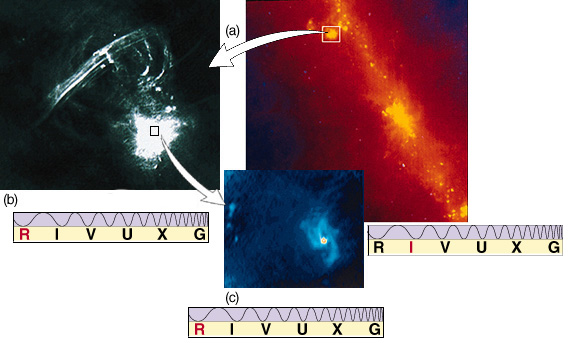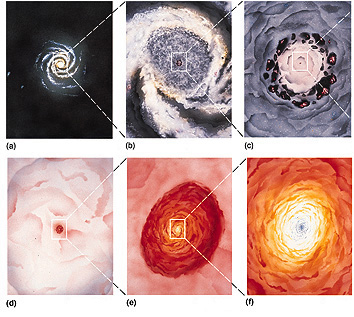Theory predicts that the Galactic bulge, and especially the region close to the Galactic center, should be densely populated with billions of stars. However, we are unable to see this region of our Galaxy—the interstellar medium in the Galactic disk shrouds what otherwise would be a stunning view. Figure 23.22 shows the (optical) view we do have of the region of the Milky Way toward the Galactic center, in the general direction of the constellation Sagittarius.
Figure 23.22 A photograph of stellar and interstellar matter in the direction of the Galactic center. Because of heavy obscuration, even the largest optical telescopes can see no farther than 1/10 the distance to the center. The M8 nebula (arrow) can be seen at extreme top center. The field is roughly 20 °, top to bottom, and is a continuation of the bottom part of Figure 18.6. The circle indicates the location of the center of our Galaxy.
With the help of infrared and radio techniques we can peer more deeply into the central regions of our Galaxy than we can by optical means. Infrared observations (Figure 23.23a) indicate that the heart of our Galaxy harbors roughly 50,000 stars per cubic parsec. That's a stellar density about a million times greater than in our solar neighborhood, high enough that stars must experience frequent close encounters and even collisions. Infrared radiation has also been detected from what appear to be huge clouds rich in dust. In addition, radio observations indicate a ring of molecular gas nearly 400 pc across, containing some 30,000 solar masses of material and rotating at about 100 km/s. The origin of this ring is unclear, although researchers suspect that the gravitational influence of our Galaxy's elongated, rotating bulge may well be involved. The ring surrounds a bright radio source that marks the Galactic center.

Figure 23.23 (a) An infrared image of the region around the center of our Galaxy shows many bright stars packed into a relatively small volume. The average density of matter in this region is estimated to be about a million times that in the solar neighborhood. (b) The central portion of our Galaxy, as seen in the radio part of the spectrum. This image shows a region about 200 pc across surrounding the Galactic center (which lies within the bright blob at bottom right). The long-wavelength radio emission cuts through the Galaxy's dust, providing an image of matter in the immediate vicinity of the Galaxy's center. (c) The spiral pattern of radio emission arising from Sagittarius A, the very center of the Galaxy. The data suggest a rotating ring of matter only 5 pc across.
High-resolution radio observations show more structure on small scales. Figure 23.23(b) shows the bright radio source Sagittarius A, which lies at the center of the circle in Figure 23.22 and within the boxed region in Figure 23.23(a) and, we think, at the center of our Galaxy. On a scale of about 100 pc, extended filaments can be seen. Their presence suggests to many astronomers that strong magnetic fields operate in the vicinity of the center, creating structures similar in appearance to (but much larger than) those observed on the active Sun. On even smaller scales (Figure 23.23c) the observations indicate a rotating ring or disk of matter only a few parsecs across.
What could cause all this activity? An important clue comes from the Doppler broadening of infrared spectral lines emitted from the central swirling whirlpool of gas. The extent of the broadening indicates that the gas is moving very rapidly. In order to keep this gas in orbit, whatever is at the center must be extremely massive—a million solar masses or more. Given the twin requirements of large mass and small size, a leading contender is a black hole. The hole itself is not the source of the energy, of course. Instead, the vast accretion disk of matter being drawn toward the hole by the enormous gravity emits the energy as it falls in, just as we saw (on a much smaller scale) in Chapter 22 when we discussed X-ray emission from neutron stars and stellar-mass black holes
(Secs. 22.3, 22.7) The strong magnetic fields are thought to be generated within the accretion disk as matter spirals inward, and may act as "particle accelerators," creating the extremely high-energy particles detected on Earth as cosmic rays (see Interlude 23-3). Astronomers have reason to suspect that similar events are occurring at the centers of many other galaxies.
Figure 23.24 places these findings into a simplified perspective. Each frame is centered on the Galaxy's core, and each increases in resolution by a factor of 10. Frame (a) renders the Galaxy's overall shape, as painted in Figure 23.15. The scale of this frame measures about 100 kpc from top to bottom. Frame (b) spans a distance of 10 kpc from top to bottom and is nearly filled by the great circular sweep of the innermost spiral arm. Moving in to a 1-kpc span, frame (c) depicts the 400-pc ring of matter mentioned earlier. The dark blobs represent giant molecular clouds, the pink patches emission nebulae associated with star formation within those clouds.

Figure 23.24 Six artist's conceptions, each centered on the Galactic center and each increasing in resolution by a factor of 10. Frame (a) shows the same scene as Figure 23.15. Frame (f) is a rendition of a vast whirlpool within the innermost parsec of our Galaxy. The data imaged in Figure 23.23 do not closely match these artistic renderings because the Figure 23.23 view is parallel to the Galactic disk, whereas these six paintings portray an idealized version perpendicular to that disk.
In frame (d), at 100 pc, a pinkish region of ionized gas surrounds the reddish heart of the Galaxy. The source of energy producing this vast ionized cloud is assumed to be related to the activity in the Galactic center. Frame (e), spanning 10 pc, depicts the tilted, spinning whirlpool of hot (104 K) gas that marks the center of our Galaxy. The innermost part of this gigantic whirlpool is painted in frame (f), in which a swiftly spinning, white-hot disk of gas with temperatures in the millions of kelvins nearly engulfs a massive black hole too small in size to be pictured (even as a minute dot) on this scale.
At the very center of our Galaxy is a remarkable object with the odd-sounding name Sgr A* (pronounced "saj-ay-star"). By the standards of the active galaxies to be studied in Chapter 25, this compact galactic nucleus is not particularly energetic. Still, radio observations made during the past two decades, along with more recent X- and gamma-ray observations, suggest that it is nevertheless a pretty violent place. Its total energy output (at all wavelengths) is estimated to be 1033 W, which is more than a million times that of the Sun.
VLBI observations using radio telescopes arrayed from Hawaii to Massachusetts imply that Sgr A* cannot be much larger than 10 A.U., and it is probably a good deal smaller than that. This size is consistent with the view that the energy source is a massive black hole, although the case is not airtight. The main alternatives are that Sgr A* could be a multiple supernova of some sort (but we detect no expansion of debris), a rapidly moving neutron star (but Sgr A* seems to be more or less fixed relative to the surrounding galaxy), a large star cluster (but the energy-emitting region seems far too small), or even an ordinary neutron star embedded within a very unusual radio source (but that seems too ad hoc).
Some recent findings support the black hole picture. Infrared spectroscopic observations of two dozen stars within a few arc seconds of Sgr A* indicate that their orbital speeds are greater the closer they are to the center—just as one would expect for matter orbiting near a large black hole. In addition, an adaptive-optics infrared imaging camera has spotted a bright source very close to Sgr A* that seems to vary with a 10-minute period; this could be a hot spot on the accretion disk that circles the purported hole. The accumulated data imply that Sgr A* contains about 1—2 million solar masses. Even with this large mass, if Sgr A* is a genuine black hole, then the size of its event horizon is still only 0.02 A.U. Such a small region, 8 kpc away, is currently unresolvable with any telescope now in existence.
If our knowledge of the Galaxy's center seems sketchy, that's because it is sketchy. Astronomers are still deciphering the clues hidden within its invisible radiation. We are only beginning to appreciate the full magnitude of this strange new realm deep in the heart of the Milky Way.